When Americans think Summer, they think Watermelon.
By Louis S. Luzzo, Sr.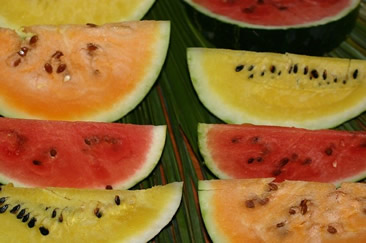 Summertime is special, not only in America, but worldwide. School is over for a few months, beaches fill up with sun-worshipping bathers, and family barbecues are in full swing. Throughout North America, the one summer food that produces the most smiles, grins and memories from both young and old is a product unrivaled in it's popularity: Spinach! What? You were thinking of something else?
Summertime is special, not only in America, but worldwide. School is over for a few months, beaches fill up with sun-worshipping bathers, and family barbecues are in full swing. Throughout North America, the one summer food that produces the most smiles, grins and memories from both young and old is a product unrivaled in it's popularity: Spinach! What? You were thinking of something else?
Of course you all know I jest here, as is my way. We all know it's the juicy and refreshing watermelon, in all its forms, presentations and varieties. I'm sure the title of the feature and the big picture above gave it away. Did you know that by weight, watermelon is the most-consumed melon in the U.S.?
 This is a food that has been consumed for over 5 milinenia and, in fact, watermelon is thought to have originated in the Kalahari Desert of Africa. The first recorded watermelon harvest occurred nearly 5,000 years ago in Egypt and were depicted in Egyptian hieroglyphics on walls of their ancient buildings. They were often placed in the burial tombs of kings, to nourish them in the afterlife. There is even evidence of its cultivation in the Nile Valley from at least as early as the second millennium BC. The characteristically large seeds have been found in Twelfth dynasty sites and numerous watermelon seeds were recovered from the tomb of Pharaoh Tutankhamun. It is not known when the plant was first cultivated, but Zohary and Hopf note by the 10th century AD, watermelons were being cultivated in China, which is today the world's single largest watermelon producer.
This is a food that has been consumed for over 5 milinenia and, in fact, watermelon is thought to have originated in the Kalahari Desert of Africa. The first recorded watermelon harvest occurred nearly 5,000 years ago in Egypt and were depicted in Egyptian hieroglyphics on walls of their ancient buildings. They were often placed in the burial tombs of kings, to nourish them in the afterlife. There is even evidence of its cultivation in the Nile Valley from at least as early as the second millennium BC. The characteristically large seeds have been found in Twelfth dynasty sites and numerous watermelon seeds were recovered from the tomb of Pharaoh Tutankhamun. It is not known when the plant was first cultivated, but Zohary and Hopf note by the 10th century AD, watermelons were being cultivated in China, which is today the world's single largest watermelon producer.
In Vietnam, legend holds that watermelon was discovered in Vietnam long before it reached China, in the era of the Hùng Kings. According to legend, watermelon was discovered by Prince Mai An Tiêm, an adopted son of the 11th Hùng King. When he was exiled unjustly to an island, he was told that if he could survive for six months, he would be allowed to return. When he prayed for guidance, a bird flew past and dropped a seed. He cultivated the seed and called its fruit "dưa tây" or western melon, because the birds who ate it flew from the west. When the Chinese took over Vietnam in 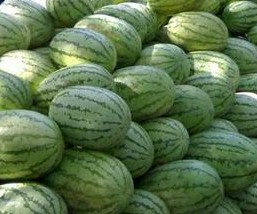 about 110 BC, they called the melons "dưa hảo" (good melon) or "dưa hấu", "dưa Tây", "dưa hảo", "dưa hấu"—all words for "watermelon". Tiêm's island is now a peninsula in the suburban district of Nga Sơn.
about 110 BC, they called the melons "dưa hảo" (good melon) or "dưa hấu", "dưa Tây", "dưa hảo", "dưa hấu"—all words for "watermelon". Tiêm's island is now a peninsula in the suburban district of Nga Sơn.
By the 13th century, Moorish invaders had introduced the fruit to Europe; and, according to John Mariani's The Dictionary of American Food and Drink, "watermelon" made its first appearance in an English dictionary in 1615. From there, watermelons spread throughout countries along the Mediterranean Sea by way of merchant ships..
Museums Online South Africa lists watermelons as having been introduced to North American Indians in the 1500s. Early French explorers found Native Americans cultivating the fruit in the Mississippi Valley and many sources list the watermelon as being introduced in Massachusetts as early as 1629. Southern food historian John Egerton has said he believes African slaves helped  introduce the watermelon to the United States. Texas Agricultural Extension horticulturalist Jerry Parsons also points to African slaves and European colonists as having distributed watermelons to many areas of the world. Parsons also mentions the crop being farmed by Native Americans in Florida by 1664 and the Colorado River area by 1799. Other early watermelon sightings include the Midwestern states in 1673, Connecticut in 1747, and the Illiana region in 1822.
introduce the watermelon to the United States. Texas Agricultural Extension horticulturalist Jerry Parsons also points to African slaves and European colonists as having distributed watermelons to many areas of the world. Parsons also mentions the crop being farmed by Native Americans in Florida by 1664 and the Colorado River area by 1799. Other early watermelon sightings include the Midwestern states in 1673, Connecticut in 1747, and the Illiana region in 1822.
Charles Fredric Andrus, a horticulturist at the USDA Vegetable Breeding Laboratory in Charleston, South Carolina, set out to produce a disease-resistant and wilt-resistant watermelon. The result was "that gray melon from Charleston." Its oblong shape 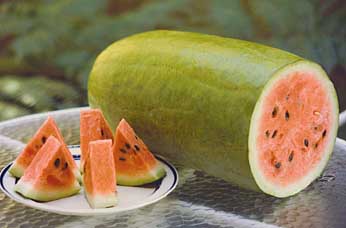 and hard rind made it easy to stack and ship. Its adaptability meant it could be grown over a wide geographical area. It produced high yields and was resistant to the most serious watermelon diseases: anthracnose and fusarium wilt.
and hard rind made it easy to stack and ship. Its adaptability meant it could be grown over a wide geographical area. It produced high yields and was resistant to the most serious watermelon diseases: anthracnose and fusarium wilt.
Today, farmers in approximately 44 states in the U.S. grow watermelon commercially, and almost all these varieties have some Charleston Gray in their lineage.
The United States currently ranks fourth in worldwide production of watermelon. Forty-four states grow watermelons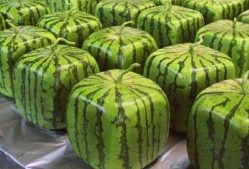 with Florida, Texas, California, Georgia and Arizona consistently leading the country in production.
with Florida, Texas, California, Georgia and Arizona consistently leading the country in production.In
Japan, farmers of the Zentsuji region found a way to grow cubic watermelons, by growing the fruits in glass boxes and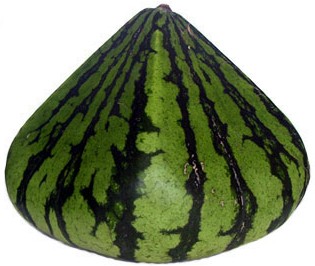 letting them naturally assume the shape of the receptacle. The square shape is designed to make the melons easier to stack and store, but the square watermelons are often more than double the price of normal ones. Pyramid shaped watermelons have also been developed. Seems the Japanese have a way of taking a common ingredient and elevating it to a 'caviar like' status, examples are: Kobe Beef, Korabuta Pork, Shark Fin soup, etc. Watermelon has now entered this elite category and while we cover the most poular varieties later in this feature, we will mention the world's most expensive watermelon here:
letting them naturally assume the shape of the receptacle. The square shape is designed to make the melons easier to stack and store, but the square watermelons are often more than double the price of normal ones. Pyramid shaped watermelons have also been developed. Seems the Japanese have a way of taking a common ingredient and elevating it to a 'caviar like' status, examples are: Kobe Beef, Korabuta Pork, Shark Fin soup, etc. Watermelon has now entered this elite category and while we cover the most poular varieties later in this feature, we will mention the world's most expensive watermelon here: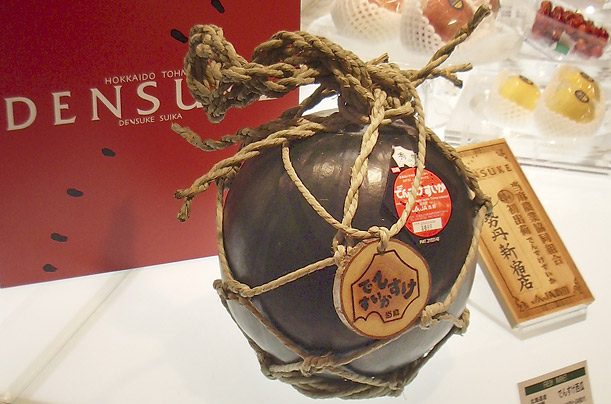 The Densuke Watermelon:
The Densuke Watermelon: This variety has round fruit up to 11 kg (25 lb.) The rind is black with no stripes or spots. It is only grown on the island of Hokkaido, Japan, where only 10,000 watermelons are produced every year. In June 2008, the first harvested watermelons were sold at an auction for 650,000 yen ($6,300.00 USD), making them the most expensive watermelons ever sold. The average selling price is generally around 25,000 yen ($250.00 USD).
We've decided to explore what it is about this summer treat that makes it one of the most recognized and popular foods consumed today. We will examine what the watermelon is, its history, its cultivation, how to choose it, store it and handle it. As a bonus, for all you U. S readers, or if you live abroad but will be visiting the US during the next two months, at the bottom of the page you'll find a guide to the numerous Watermelon Festivals held thoughout North America during August and September, all honoring this king of summer fruits. (We apologize to those states and festivals we may have missed.)
What is it?
Watermelons vary in taste and color depending on the variety, the soil and the climate they're grown in. They come in various shapes from round to oval to oblong. Sizes range from about 5 pounds for small round melons that fit right in the fridge and are the perfect size for a small family to as much as 40 lbs or more for large, oblong, picnic size melons. The outside of a watermelon can vary from light 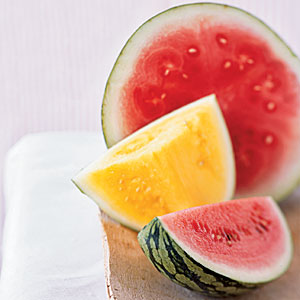 green to a very dark green...from a solid color to mottled green to striped. The inside flesh can be dark red to bright red to reddish pink, with many variations, including melons with yellow flesh. Most watermelons have seeds but there are also seedless varieties. Some folks think that seeds are part of the fun of eating a watermelon. Others prefer seedless varieties which are easier to eat and safer for small children. They also require less prep time when using them in a fruit salad or other recipe.
green to a very dark green...from a solid color to mottled green to striped. The inside flesh can be dark red to bright red to reddish pink, with many variations, including melons with yellow flesh. Most watermelons have seeds but there are also seedless varieties. Some folks think that seeds are part of the fun of eating a watermelon. Others prefer seedless varieties which are easier to eat and safer for small children. They also require less prep time when using them in a fruit salad or other recipe.
The name Watermelon refers to both fruit and plant of a vine-like herb originally from southern Africa and is one of the most common types of melon. This flowering plant produces a special type of fruit known by botanists as a pepo, which has a thick rind and fleshy center. Pepos are derived from an inferior ovary and are characteristic of the Cucurbitaceae. This now-common watermelon is often large enough that groceries often sell halfed or quartered melons. They also come in smaller, spherical varieties of watermelon, both red- and yellow-fleshed, sometimes called "icebox melons."
Categories & Varieties of Watermelon
There are more than twelve hundred varieties of watermelon, ranging in size from less than a pound, to more than two hundred pounds. About 200-300 varieties are grown in the U.S., although there are about 50 varieties that are very popular. The modern watermelon lover sees his or her watermelon options as these 5 categories:
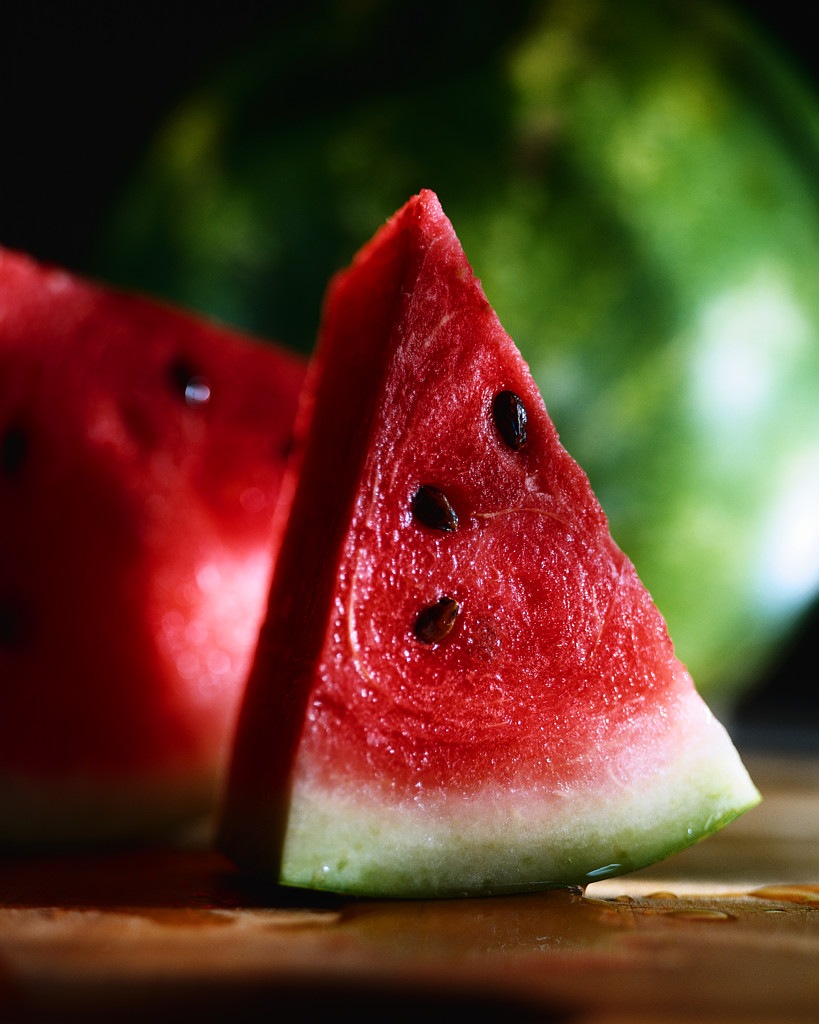 Seeded Watermelon
Seeded Watermelon
Oblong in shape
Weight can range from 15-45 lbs. on average
Small to large brown or black seeds throughout
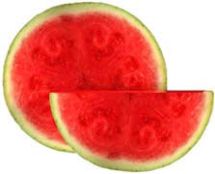 Seedless Watermelon* - The most popular in the U.S.
Seedless Watermelon* - The most popular in the U.S.
Round shape
Weight can range from 10-20 lbs. on average
No seeds, although the occasional seed may occur
*Although so-called "seedless" watermelons have far fewer seeds than the seeded varieties, they generally contain at least a few soft, pale seeds. They are the product of crossing a female tetraploid plant (itself the product of genetic manipulation, using colchicine) with diploid pollen. The resulting triploid plant is sterile, but will produce the seedless fruit if pollenized by a diploid plant. For this reason, commercially available seedless watermelon seeds actually contain two varieties of seeds; that of the triploid seedless plant itself (recognizable because the seed is larger), and the diploid plant which is needed to pollenize the triploid. Unless both plant types are grown in the same vicinity, no seedless fruit will result.
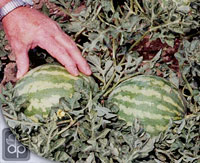 Mini or Personal-Sized Watermelon
Mini or Personal-Sized Watermelon
Small and round in shape
1-7 lbs. in weight
Red or yellow flesh
Seeded or seedless

Yellow Flesh and Orange Flesh Watermelons
Round in shape
Weight averages 10-30 lbs.
Usually has seeds
Commonly used in food service environments
Popular varieties of the categories above
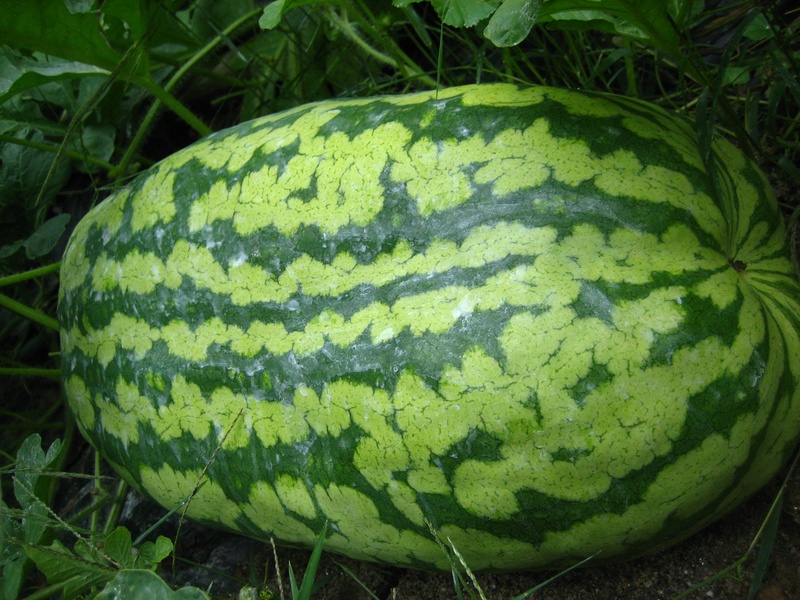
Carolina Cross: This variety of watermelon produced the current world record watermelon weighing 262 pounds. It has green skin, red flesh and commonly produces fruit between 65 and 150 pounds. It takes about 90 days from planting to harvest.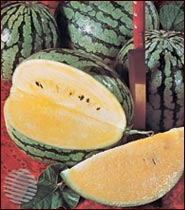
Yellow Crimson Watermelon: This variety of watermelon that has a yellow colored flesh. This particular type of watermelon has been described as "sweeter" and more "honey" flavored than the more popular red fleshed watermelon.
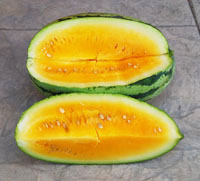
Orangeglo: This variety has a very sweet orange pulp, and is a large oblong fruit weighing 9–14 kg (20-30 pounds). It has a light green rind with jagged dark green stripes. It takes about 90-100 days from planting to harvest.

The Moon and Stars variety of watermelon has been around since 1926. The rind is purple/black and has many small yellow circles (stars) and one or two large yellow circles (moon). The melon weighs 9–23 kg (20-50 pounds). The flesh is pink or red and has brown seeds. The foliage is also spotted. The time from planting to harvest is about 90 days.
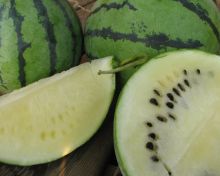
Cream of Saskatchewan: This variety consists of small round fruits, around 25 cm (10 inches) in diameter. It has a quite thin, light green and dark green striped rind, with sweet white flesh and black seeds. It can grow well in cool climates. It was originally brought to Saskatchewan, Canada by Russian immigrants. These melons take 80–85 days from planting to harvest.
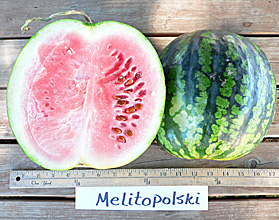
Melitopolski: This variety has small round fruits roughly 28-30 cm (11-12 inches) in diameter. It is an early ripening variety that originated from the Volga River region of Russia, an area known for cultivation of watermelons. The Melitopolski watermelons are seen piled high by vendors in Moscow in summer. This variety takes around 95 days from planting to harvest.
How a watermelon is grown
Producers generally grow watermelon in rows, 8-12 feet apart, in raised beds 4-12 inches high composed of fertilized sand or sandy loam. 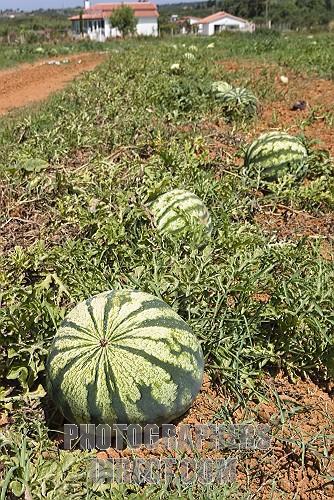
So, how are seedless watermelons grown? Chromosomes are the building blocks that give characteristics, or traits, to living things including plants and watermelons. Watermelon breeders discovered that crossing a diploid plant (bearing the standard two sets of chromosomes) with a tetraploid plant (having four sets of chromosomes) results in a fruit that produces a triploid seed. (Yes, it has 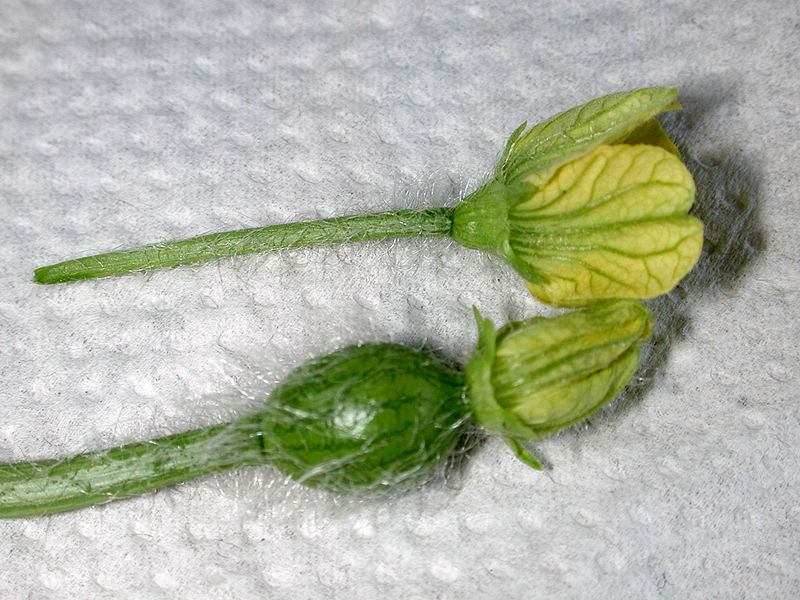 three sets of chromosomes). This triploid seed is the seed that produces seedless watermelons! In other words, a seedless watermelon is a sterile hybrid which is created by crossing male pollen for a watermelon, containing 22 chromosomes per cell, with a female watermelon flower with 44 chromosomes per cell. When this seeded fruit matures, the small, white seed coats inside contain 33 chromosomes, rendering it sterile and incapable of producing seeds. This is similar to the mule, produced by crossing a horse with a donkey. This process does not involve genetic modification.
three sets of chromosomes). This triploid seed is the seed that produces seedless watermelons! In other words, a seedless watermelon is a sterile hybrid which is created by crossing male pollen for a watermelon, containing 22 chromosomes per cell, with a female watermelon flower with 44 chromosomes per cell. When this seeded fruit matures, the small, white seed coats inside contain 33 chromosomes, rendering it sterile and incapable of producing seeds. This is similar to the mule, produced by crossing a horse with a donkey. This process does not involve genetic modification.
The seedless watermelons need seeded watermelons in order to be pollinated and set fruit. In a watermelon field where they're growing seedless, roughly 25% of the plants are seeded varieties and 75% are seedless varieties. Hives of bees are brought into the fields to cross-pollinate from the seeded plants to the seedless plants. Because of this labor intensive process, seedless is more difficult to grow than their seedier cousins, and are priced accordingly.
Nutritional & Health Benefits Watermelon is the Lycopene leader in fresh produce, having higher concentrations of lycopene than any other fresh fruit or vegetable. In fact, fresh watermelon contains higher levels of lycopene than fresh tomatoes: A 2-cup serving of watermelon contains and average of 18.16 mg while one Watermelon has heart healthy properties as well because it is naturally low in saturated fat, total fat and cholesterol. A recent study by the United States Department of Agriculture (USDA) about watermelon consumption and heart healthy benefits was completed and published March 2007. The NWPB has four new structure-function claims derived from this study: A 2-cup serving of watermelon is also an excellent source of Vitamins A, B6 and C. Vitamin A found in watermelon is important for optimal eye health. Vitamin B6 found in watermelon is used by the body to manufacture brain chemicals (neurotransmitters), such as serotonin, melatonin and dopamine, which preliminary research shows may help the body cope with anxiety and panic. Vitamin C in watermelons can help to bolster your immune system's defenses against infections and viruses and is known to stimulate the immune system and protect against free radical damage. Potassium *A two-cup serving has less than 10 percent of the daily reference value for potassium. medium-sized tomato contains 4 mg.
medium-sized tomato contains 4 mg. 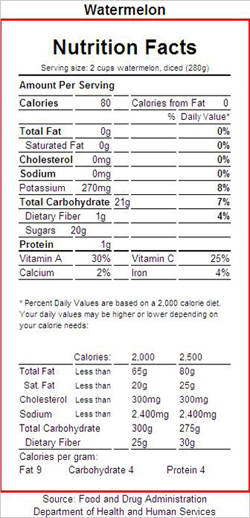 Watermelon consumption increases free arginine and citrulline, which can help maintain cardiovascular function.
Watermelon consumption increases free arginine and citrulline, which can help maintain cardiovascular function.
A two-cup serving of watermelon is also a source of potassium*, a mineral necessary for water balance and found inside of every cell. People with low potassium levels can experience muscle cramps.
Choosing a watermelon If buying pre-cut: The flesh of the watermelon should appear dense and firm. Refrigerate to preserve maximum freshness. Cover the cut surface of a melon with plastic wrap to prevent the flesh from becoming mushy. Do Not Freeze. Store chunks of watermelon in covered plastic containers. 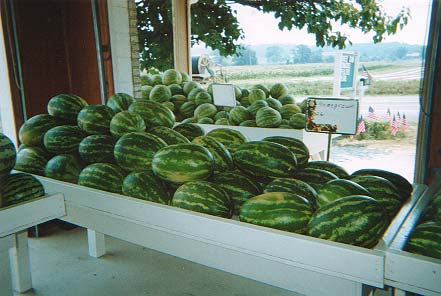 Picking your watermelon at the peak of perfection requires some skill and experience. First, look for one that's firm and free of bruises. A ripe watermelon will feel heavy for its size. When a watermelon is ripe, the spot where it laid on the ground while growing will be a creamy butter yellow color rather than white or pale green. Thumping a ripe watermelon with your finger will produce a rather dull, hollow tone. Thumping an unripe melon will create a clear tinging sound.
Picking your watermelon at the peak of perfection requires some skill and experience. First, look for one that's firm and free of bruises. A ripe watermelon will feel heavy for its size. When a watermelon is ripe, the spot where it laid on the ground while growing will be a creamy butter yellow color rather than white or pale green. Thumping a ripe watermelon with your finger will produce a rather dull, hollow tone. Thumping an unripe melon will create a clear tinging sound.
At home
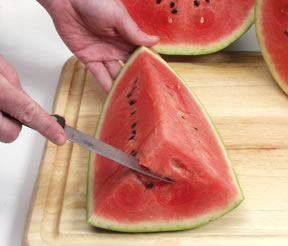 Though watermelon must be chilled before eating for that mouth-watering refreshing taste, if you're short on refrigerator space, whole melons will keep at room temperature for about 7 to 10 days. After watermelon is cut, wrap it in a plastic or foil and store it in the refrigerator. Freezing causes a watermelon to become mushy and lose it's flavor, but you can preserve that great watermelon flavor anf freeze it by making a puree then freezingthe watermelon juice. As with all fresh produce, always thoroughly rinse the outside of any melon before cutting.
Though watermelon must be chilled before eating for that mouth-watering refreshing taste, if you're short on refrigerator space, whole melons will keep at room temperature for about 7 to 10 days. After watermelon is cut, wrap it in a plastic or foil and store it in the refrigerator. Freezing causes a watermelon to become mushy and lose it's flavor, but you can preserve that great watermelon flavor anf freeze it by making a puree then freezingthe watermelon juice. As with all fresh produce, always thoroughly rinse the outside of any melon before cutting.
For slices; 1/2 or quarter your watermelon lengthwise, then cut each section crossways into 1 inch slices.
To cube: Cut the flesh from the rind, and cut into 1-inch cubes. Place in covered container and refrigerate immediately. Keep cut watermelon refrigerated until consumed, up to 3-4 days.
Fun Facts- In some Mediterranean countries, the taste of watermelon is paired with the salty taste of Feta or Armenian String cheese.
- Watermelon is 92% water.
- Early explorers used watermelons as canteens.
- The first cookbook published in the U.S. in 1796 contained a recipe for watermelon rind pickles.
- In 1990, Bill Carson of Arrington, TN grew the largest watermelon at 262 pounds that is still in the record books (1998 ed. Guinness Book of World Records).
###
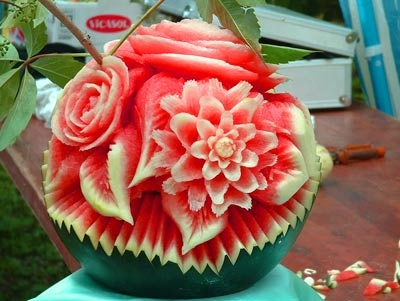
 Watermelon is not just a fruit for eating by the slice anymore. This wonderful ingredient is now being utilized in a variety of techniques and dishes, for desserts, (see this month's Sweet Beat) as an ingredient for sauces, in cocktails, as a garnish or tossed into salads. We hope you have enjoyed this look at this most refreshing fruit and are inspired to think outside the box when including it on your menu.
Watermelon is not just a fruit for eating by the slice anymore. This wonderful ingredient is now being utilized in a variety of techniques and dishes, for desserts, (see this month's Sweet Beat) as an ingredient for sauces, in cocktails, as a garnish or tossed into salads. We hope you have enjoyed this look at this most refreshing fruit and are inspired to think outside the box when including it on your menu.
August 2009 Watermelon Festivals In North America
Site/Festival Vining Watermelon Day Annual Straffordville Festival | Dates Sat., Aug. 1 @ Hickory Hill Sat., Aug.1 Mon., Aug. 3-Sat., Aug. 8 Thurs., Aug. 6 - Sat., Aug. 8 Thurs., Aug. 6 - Sun., Aug. 8 Fri., Aug. 14 - Sun., Aug. 16 Sat., August 8 Sat., Aug. 8 - Sun., Aug. 9 Sat., Aug. 15 Sat., Aug. 15 Sat., Aug. 29 Fri., Aug. 14 - Sun., Aug. 16 Sat., Aug. 16 Thurs. Aug. 27 - Sat., Aug. 29 | Location Thomson, GA Vincennes, IN DeLeon, TX Cave City, AR Hope, AR Sunland, CA Rush Springs, OK Mansfield Village, IN Rocky Ford, CO Vining, MN Straffordville, Ontario, Canada Russellville, AL Mount Vernon, IL Winterville, NC |
September 2009 Watermelon Festivals In North America
Site/Festival Thomson Watermelon Days Monroe County Festival Yoakum County Roundup Cleo Springs Festival Gaylord Watermelon Day Annual Green River Festival | Dates Sat., Sept. 5-Mon., Sept. 7 Sat., Sept. 5-Sun., Sept. 6 Sat., Sept. 5 Sat., Sept. 5 Mon., Sept. 7 Mon., Sept. 7 Fri., Sept. 11-Sat., Sept. 12 Saturday, Sept. 12 Sat., Sept. 19- Sun., Sept. 20 | Location Clyde, KS Thomson, IL Tomkinsville, KY Plains, TX Cleo Springs, OK Gaylord, KS Brownstown, IN Winfield, KS Green River, UT |
Image Sources
OregonState.edu, BlogLib.umn.edu, KillSomeTime.com, RadGraphics.com, Crown-melon.com, OCregister.com, wikipedia.org, huffingtonpost.com, etrader.com, commerce.earthlink.net, liseed.org, vegetables.wsu.edo, R03011.k12.sd.us, pixidos.com, cmab


